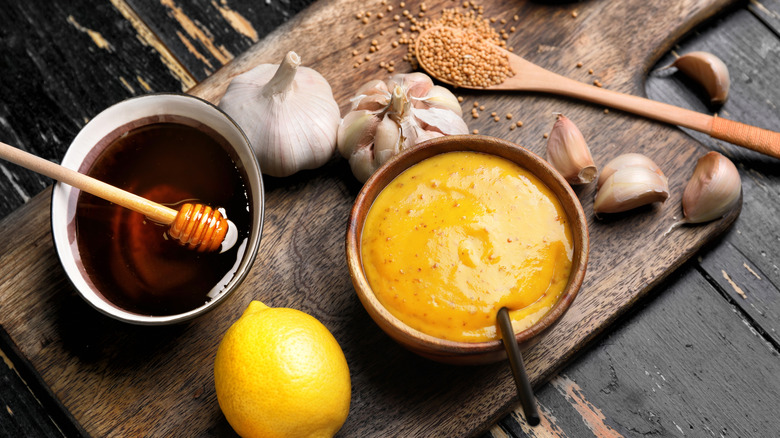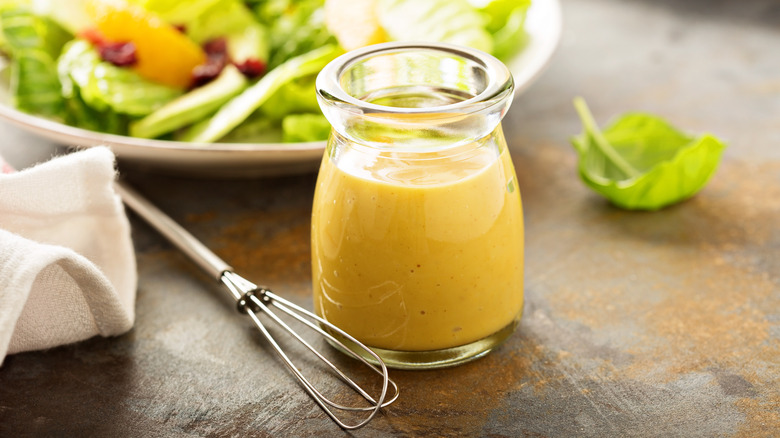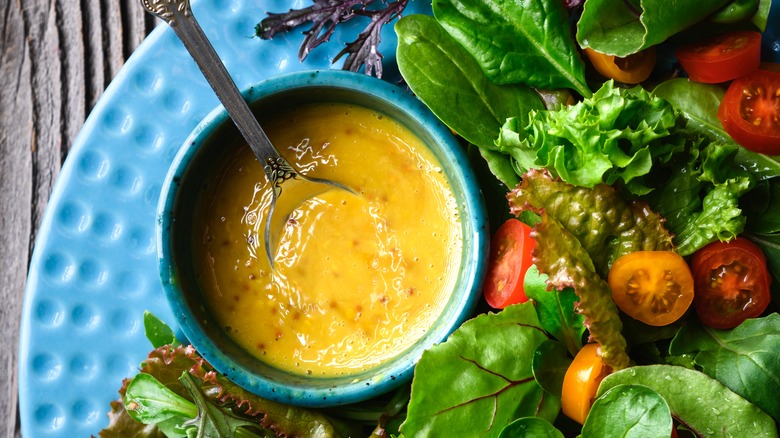What's The Actual Difference Between Honey Mustard Sauce And Dressing?
Few flavor combinations are as unexpectedly delicious as honey and mustard. There's something about the sweetness of honey that's the perfect balancing agent for mustard's sharpness. As they say, opposites attract. Curiously, this special combo is not a novelty: It was well known in Ancient Egypt and Rome, and it consistently makes an appearance in what is believed to be the oldest cookbook in the world.
The older versions were quite different from what we know today. For instance, Romans used honey and mustard in combination with a host of interesting spices, and paired it with proteins such as ostrich, boar, and sea scorpions. These days, a blend of honey and mustard is most often preferred with salads, chicken dishes, burgers, and french fries. It offers an easy way of adding depth to a dish that might otherwise taste a bit bland. By simultaneously enhancing it with extra sweetness and spice, honey mustard also brings a touch of creativity.
This notable combination comes as both a thick sauce and a drippy dressing. Though similar in flavor profile, there are some key differences between the two that significantly affect what kind of dishes they pair well with. They diverge in ingredients, consistency, flavor intensity, and the way they're used. Let's explore what makes each of them unique.
What is honey mustard sauce?
Honey mustard sauce is a popular and versatile condiment that's stocked in many American pantries. It's made with mayonnaise and a splash of acid, in addition to honey and mustard. The mayo gives the sauce its thick consistency making it perfect for dipping. It also provides the creaminess, ideal for sandwiches and burgers that need a spreadable sauce that won't turn the bread soggy.
The flavor of honey mustard sauce is very rich. In terms of sweetness, it's easy for the pendulum to swing in either direction — a bit sweeter (made with more honey) or sharper (made with more mustard). Ratios often come from personal preference, but most are aiming for the golden middle. The sauce is very forgiving when you're adapting the recipe, giving you the option of lowering the mayo content or skipping it entirely and opting for sour cream or Greek yogurt as the creamy base instead. Despite the flexibility the sauce offers when made from scratch, you can also look to the many brands selling a version of it and find your favorite.
Over time, we've kept a lot of things from the Romans, and pairing this delicious sauce predominantly with meat is one of them. It's often used alongside chicken, giving this relatively dry type of protein a tasty and juicy texture (exhibit A: our delicious honey mustard chicken thighs recipe). The sauce also impresses in combination with pork, beef, and fish, especially if you're using it to top grilled meats.
What is honey mustard dressing?
Honey mustard dressing appears to have evolved from the sauce, though its exact origins are shrouded in mystery. In 1942, it was mentioned as a fruit salad dressing in the Los Angeles Times, and the dressing continued to gain popularity throughout the 20th century alongside the sauce. Today, it's one of the most recognizable salad dressings on the market.
In comparison to the sauce, honey mustard dressing has a visibly thinner consistency. It's runny and perfect for drizzling onto a salad without completely overpowering it. The four basic ingredients in a classic honey mustard dressing recipe are honey, mustard, acid, and oil. The choice of oil and acid can be as simple as opening your pantry to see what you have in stock (we use olive oil and lemon in our fried goat cheese salad recipe). However, the oil is the key ingredient here — it gives the dressing its pourable, vinaigrette-like consistency that's in stark contrast with the thick, syrupy sauce.
The flavor of the dressing is slightly more on the acidic side and doesn't have the same depth as the sauce. That doesn't mean it's not delicious, only that it is a bit tamer. The oil dilutes the distinct flavors of mustard and honey, giving the dressing a lighter aroma that's suitable for less-hefty meals such as salads. From acting as the unconventional dressing on a wedge salad to giving potato salad a sweet and tangy twist, honey mustard dressing delivers the goods.
The dressing can be used for marinating meat, while the sauce is great for coating it
Honey mustard sauce and dressing can both be used for improving the texture and flavor of grilled meat, but in different ways. The dressing can be repurposed into a juicy marinade, as long as you add even more acidity. A high quotient of acid is necessary in every good marinade because it's what softens the meat, giving us the tender result we're aiming for. Simply enhancing honey mustard dressing with additional lemon or vinegar will do the trick; you could also add chili powder for some heat and additional spices for more flavor.
On the flip side, honey mustard sauce is fantastic for coating meat that's about to go on the grill (or in the oven). Using mayo to grill fish and meat is a known trick in the culinary world — mayonnaise is an emulsion so it sticks to the meat better than oil, preventing it from clinging to the grill or losing all the moisture during the cooking process. This is especially helpful when you're grilling delicate fish. Because honey mustard sauce is mayo-based, you can use it in place of plain mayonnaise to coat the meat before grilling it, with a slight adjustment: Grill the coated meat over indirect heat first, and only move it to direct heat for a nice sear at the end. Otherwise, the honey in the sauce could burn too quickly.
Flavor-wise, the sauce is the focal point of the dish while the dressing is a supporting act
Honey mustard sauce and dressing certainly differ in flavor intensity. The sauce has a richer, more powerful flavor which usually becomes the focal point of the dish. It lends its sweet and spicy notes to whatever it's paired with (even something as basic as canned beans), instantly standing out as the dominant flavor. This feature, too, is a consequence of its mayonnaise base; mayo is a great neutral vehicle for any accompanying flavors, bringing both honey and mustard straight to the forefront.
The dressing, however, is more of a supporting act. It has lighter notes due to its thin consistency, so the flavors don't stand out as much. The oil base and the addition of acid mask the intensity of mustard and slightly reduce the sweetness of honey. The dressing definitely leaves its imprint on the taste buds, but more than that it allows the other ingredients to take the spotlight.




